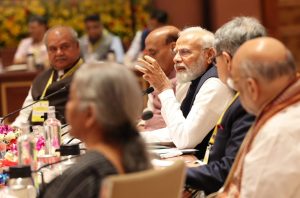INS Vikrant: Born emperor of seas; Ministers be like Marta Temido; Falling for foreign varsities

Opinion Watch
Prime Minister Narendra Modi will undeniably leave a firm imprint on the modernization of the Indian defence forces, and Vikrant, sailing in waters, with advanced fighter jets on board, would surely be a presence guaranteeing peace in the Indian Ocean.
Besides Vikrant, the Modi government may finally be laying the roadmap for phasing out the ‘flying coffins’ Mig-21 series of fighter planes, as Tejas Mark-1would replace them, while Tejas-Mark II will take guard for Jaguars, Mirage 2000s, and Mig 29.
The Times of India in its Edit has heaped praise on the Modi government for ‘Atmanirbharta” in defence sector.
The growing negative list of defence goods to be exclusively manufactured within the country, with the domestic competencies well displayed as 75 per cent of the components used in INS Vikrant have been made in India.
The daily pegs the armed forces to spend $130 billion in next five years, and that should be an assured market for the Indian manufacturers and also the startups to tell that the failure of the Kaveri engine project wouldn’t be a deterrence.
Ministers be like Marta Temido
Life of one person is highly important, and this sense of duty must make the mental-moral built of politician in positions of responsibility.
Portugal’s health minister Marta Temido quit after an Indian pregnant woman died of cardiac arrest as she was being transferred from hospital to another following unavailability of beds.
Temido is a rare politician who shows that morality in public life is still alive.
Readers are free to search for similar examples in their countries, including India.
Portugal is battling doctors’ shortage and that makes patients to travel long distances. Temido had been facing criticism on ‘weekend off-day policy’, noted The Indian Express in its Editorial.
The Covid-19 pandemic has woken up the world to face the harsh reality that the doctor-patient ratio which is horrendous in India is equally worse even in advanced countries.
Falling for foreign varsities
People do suffer from inferiority complex, but institutions too can be afflicted with such malaise is evident from the fact that the foreign varsities can just come and set up their shops in India.
Why the domestic varsities shouldn’t be also given a regulatory freedom at par with their foreign counterparts, asked The Economic Times in its lead Editorial, arguing that creating two classes of institutions will be self-defeating.
Indeed, India is aiming to double the gross enrolment ratio in the higher education from the current 27 per cent to 50 per cent by 2030, but there cannot be a short-cut.
The daily rightly lamented that a third of the colleges in the country are concentrated in just six per cent of the districts.
Quantitative and qualitative turnaround in the higher education demands democratization of the higher education infrastructure, possibly every four contiguous districts and their industrial linkages.






